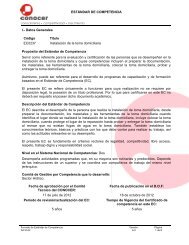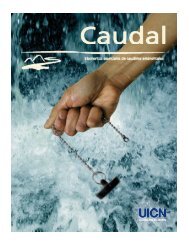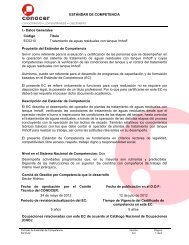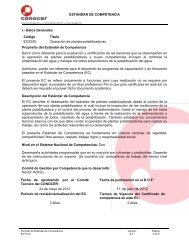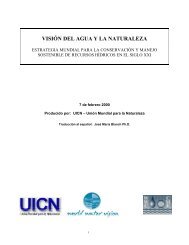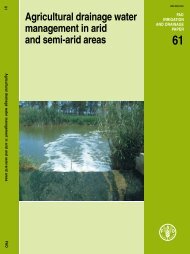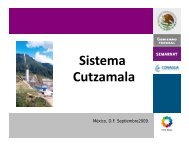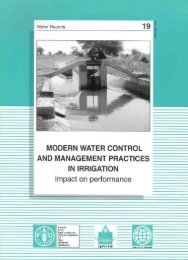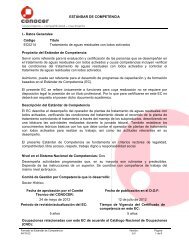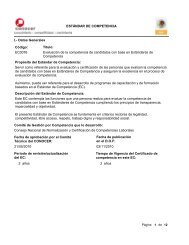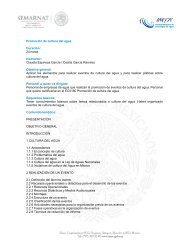An Assessment of the Status of Biodiversity in the Muthurajawela ...
An Assessment of the Status of Biodiversity in the Muthurajawela ...
An Assessment of the Status of Biodiversity in the Muthurajawela ...
Create successful ePaper yourself
Turn your PDF publications into a flip-book with our unique Google optimized e-Paper software.
7. Major threats to biodiversity <strong>in</strong> <strong>Muthurajawela</strong><br />
The location <strong>of</strong> <strong>the</strong> <strong>Muthurajawela</strong> wetland sanctuary <strong>in</strong> a rapidly develop<strong>in</strong>g urban area makes<br />
it an extremely vulnerable ecosystem. As clearly evident from <strong>the</strong> f<strong>in</strong>d<strong>in</strong>gs <strong>of</strong> <strong>the</strong> present<br />
survey, considerable changes have taken place <strong>in</strong> relation to <strong>the</strong> biodiversity <strong>of</strong> <strong>Muthurajawela</strong>,<br />
over a period <strong>of</strong> 10 years. These changes could be attributed to a comb<strong>in</strong>ation <strong>of</strong> various<br />
anthropogenic factors, that have a negative impact on biodiversity. The major threats that affect<br />
<strong>the</strong> biodiversity <strong>of</strong> <strong>the</strong> <strong>Muthurajawela</strong> wetland sanctuary can be summarized under 3 major<br />
categories: habitat deterioration/degradation; direct exploitation <strong>of</strong> species and impact <strong>of</strong> exotic<br />
species. The different factors that contribute to <strong>the</strong>se threat categories are given below:<br />
Factors result<strong>in</strong>g <strong>in</strong> deterioration/degradation <strong>of</strong> habitats<br />
The major factors that lead to <strong>the</strong> deterioration and degradation <strong>of</strong> habitats <strong>in</strong> <strong>Muthurajawela</strong><br />
<strong>in</strong>clude land reclamation (fill<strong>in</strong>g <strong>of</strong> <strong>the</strong> marsh), clear<strong>in</strong>g <strong>of</strong> vegetation, deliberate fire, dump<strong>in</strong>g<br />
<strong>of</strong> garbage, discharge <strong>of</strong> agro-chemicals and organic pollution. Illegal reclamation and fill<strong>in</strong>g<br />
is a severe problem <strong>in</strong> <strong>Muthurajawela</strong>, which has contributed to a change <strong>in</strong> vegetation and<br />
habitat types with<strong>in</strong> <strong>the</strong> sanctuary. Marshy areas are be<strong>in</strong>g filled with soil, and foreign material<br />
such as rubber refuse, poly<strong>the</strong>ne and garbage. Fill<strong>in</strong>g <strong>of</strong> land is ma<strong>in</strong>ly for construction <strong>of</strong> new<br />
houses and access roads/pathways, while <strong>the</strong> established residents also fill <strong>the</strong>ir backyards<br />
illegally, <strong>in</strong> order to widen <strong>the</strong>ir exist<strong>in</strong>g land space. Fill<strong>in</strong>g <strong>of</strong> land has also resulted <strong>in</strong> <strong>the</strong><br />
fragmentation <strong>of</strong> natural habitats and affected <strong>the</strong> free movement <strong>of</strong> water between different<br />
aquatic habitats. It has also contributed to <strong>the</strong> siltation <strong>of</strong> aquatic habitats, <strong>in</strong>clud<strong>in</strong>g <strong>the</strong> marshlagoon<br />
transition zone.<br />
Clear<strong>in</strong>g <strong>of</strong> natural vegetation is evident ma<strong>in</strong>ly around residential areas. Certa<strong>in</strong> areas <strong>of</strong><br />
scrubland have also been set on fire by <strong>the</strong> residents, and this seems to be a regular practice, to<br />
get rid <strong>of</strong> serpents enter<strong>in</strong>g home gardens. Large scale dump<strong>in</strong>g <strong>of</strong> garbage is a serious problem<br />
<strong>in</strong> <strong>Muthurajawela</strong>. This has led to <strong>the</strong> accumulation <strong>of</strong> nutrients <strong>in</strong> aquatic habitats, and poses a<br />
severe health hazard as well. It has also decreased <strong>the</strong> scenic value <strong>of</strong> this wetland.<br />
Fur<strong>the</strong>rmore, garbage dumps have also resulted <strong>in</strong> a proliferation <strong>of</strong> native opportunistic faunal<br />
species such as cattle egrets, common crows, jungle crows and <strong>the</strong> water monitor. These<br />
species, toge<strong>the</strong>r with <strong>the</strong> domestic cats and dogs which also ga<strong>the</strong>r near garbage dumps, pose<br />
a threat to native faunal species <strong>in</strong> <strong>Muthurajawela</strong>.<br />
Agro-chemicals (pesticides, chemical fertilisers) are heavily used <strong>in</strong> leafy vegetable cultivation<br />
lands, especially <strong>in</strong> <strong>the</strong> M<strong>in</strong>uwambemma area. Clear signs <strong>of</strong> eutrophication are evident <strong>in</strong><br />
aquatic habitats close to this area, as a result <strong>of</strong> nutrient accumulation. These chemical residues<br />
pose a serious threat to <strong>the</strong> aquatic organisms. The illegal breweries that produce local alcohol<br />
(‘kasippu’) also contribute to <strong>the</strong> degradation <strong>of</strong> aquatic habitats, as <strong>the</strong>y release various<br />
chemicals (<strong>in</strong>clud<strong>in</strong>g urea - N fertiliser) <strong>in</strong>to <strong>the</strong> water. In addition, small animals such as<br />
amphibians, reptiles and small mammals are also used for this process, and hence it poses a<br />
threat to <strong>the</strong>se organisms.<br />
20



